Abstract
By the examples of four typical catenas in the East European Plain, the role of lessivage in the development of automorphic and hydromorphic loamy and clayey soils with light-colored acid eluvial horizons and with different degrees of gleyzation has been studied. It is found that characteristic features of lessivage are often observed in the soils without hydrological barriers hampering or preventing the vertical migration of soil water and mass transfer processes. The hydrological barriers may be represented by the shallow horizons of temporarily perched water, or by the ascending capillary fringe of the ground water, or by the water-saturated horizons, in which the volume of free pores does not exceed 2–4%. It is shown that light-colored acid eluvial horizons may be formed in the profiles of loamy and clayey soils without any signs of lessivage. The development of strongly gleyed soils (gleyed soddy-podzolic soils and pseudogley soils (Stagnosols)) is not related to colmatage (silting of their illuvial horizons through lessivage); it is conditioned by the actual hydrological regime of these soils. The role of lessivage, podzolization, and gleyzation in the development of clay-differentiated soils is discussed.
Similar content being viewed by others
References
M. M. Abramova, Data for Characterizing Podzolic and Soddy-Podzolic Soils (Akad. Nauk SSSR, Moscow, 1961), pp. 209–258 [in Russian].
V. P. Amalitskii, Gorbanovskii District: Data on Land Evaluation in the Nizhni Novgorod Province (St. Petersburg, 1888), Vol. 7 [in Russian].
K. D. Glinka, Soil Science (Sel’khozgiz, Moscow, 1932) [in Russian].
V. V. Dokuchaev, “About Podzol,” Tr. Vol’n. Ekon. Obshch. 1(2), 142–150 (1880).
V. V. Dokuchaev, “On the Benefits of Studying Local Names of Russian Soils (1886),” Tr. Vol’n. Ekon. Obshch. 2(5), 116–118 (1887).
Duchaufour, P., Précis de pedologie, Masson and Cie, Paris, 1965, 2nd ed.; Duchaufour, P., Lévolution des sols, Masson and Cie, Paris, 1968.
A. A. Zavalishin, “Some Observations Regarding the Knowledge of Soils with Shallow Gley Horizon,” in In Memory of Academician K. D. Glinka (Akad. Nauk SSSR, Moscow, 1928) [in Russian].
F. R. Zaidel’man, “Diagnostics of Podzolic and Loess Pseudogley and Gleyic Podzolic Soils,” Pochvovedenie, No. 1, 130–140 (1973).
F. R. Zaidel’man, Podzol and Gley Formation (Nauka, Moscow, 1974) [in Russian].
F. R. Zaidel’man, Hydrological Regime of Soils in the Nonchernozemic Zone (Gidrometizdat, Leningrad, 1985) [in Russian].
F. R. Zaidel’man, Gley Formation and Its Role in Soil Formation (Mosk. Gos. Univ., Moscow, 1998) [in Russian].
F. R. Zaidel’man, “Genesis and Problems of Classification of Soils with Light-Colored Acid Eluvial Horizons,” Pochvovedenie, No. 2, 233–242 (2002) [Eur. Soil Sci. 37 (2), 199–206 (2002)].
N. N. Matinyan, Pedogenesis on Varved Clay of Glaciolacustrine Plains in the Northwestern Russia (St.-Petersburg, 2003) [in Russian].
N. D. Ponagaibo, “Natural-Historical Conditions of the Mtsena Region,” in Proceedings of the Forest-Economic Expedition: the Mtsena Expedition (Moscow, 1929), Vol. 1, pp. 50–180, 211–227, 638–642 [in Russian].
A. A. Rode, “Podzolization and Lessivage,” Pochvovedenie, No. 7, 9–23 (1964).
T. A. Sokolova, T. Ya. Dronova, and I. I. Tolpeshta, Clay Minerals in Soils (Grif, Tula, 2005) [in Russian].
A. N. Sokolovskii, “Some Observations of Soil Colloids,” Russk. Pochvoved, Nos. 4–5, 14–15 (1922).
V. D. Tonkonogov, Clay-Differentiated Soils of European Russia (Moscow, 1999) [in Russian].
V. M. Fridland, “Podzolization and Illimerization,” Pochvovedenie, No. 1, 27–38 (1958).
N. Cernescu, “Facteurs de climat et zones de sol en Roumanie,” in Inst. Geol. Roumaniei. Stud. Techn. si Economice, Ser. C (Bucuresti, 1934), No. 2.
Duchaufour, P., ’Lessivage et podsolisation,’ Rev. Forest. Fran’??c., No. 10, 652–674 (1951).
R. Dudal, “Etude morphologique et génétique d’une séquence de sols sur limon loessique,” in Extrait de Agriculture (October, 1953).
G. Krauss, Bodenart und Bodentyp, insbesondere Wasser-und Lufthaushalt der gleyartigen Bodenbildungen, Tharandt. Forstl. Yahrbuch. (1953).
W. L. Kubiena, Bestimmungsbuch und Sistematik der Boden Europas (Stuttgart, 1953).
E. Muckenhausen, “Le pseudogley,” Sci. Sol, No. 1, 21–29 (1963).
Author information
Authors and Affiliations
Additional information
Original Russian Text © F.R. Zaidel’man, 2007, published in Pochvovedenie, 2007, No. 2, pp. 133–144.
Rights and permissions
About this article
Cite this article
Zaidel’man, F.R. Lessivage and its relation to the hydrological regime of soils. Eurasian Soil Sc. 40, 115–125 (2007). https://doi.org/10.1134/S1064229307020019
Received:
Issue Date:
DOI: https://doi.org/10.1134/S1064229307020019




